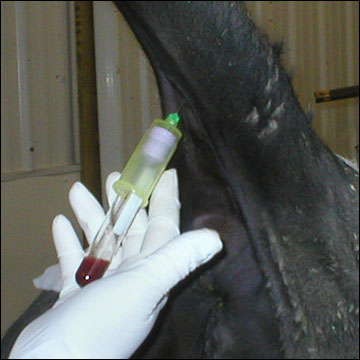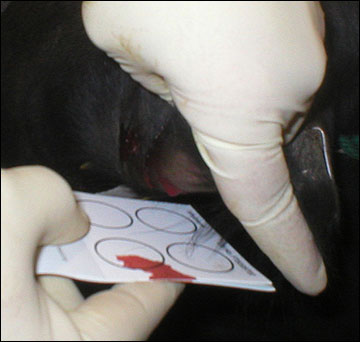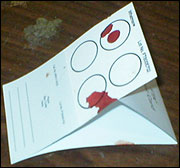The beef cattle industry has long awaited the development of genetic tests to assist producers in breeding selection and management and to improve the marketability of cattle. Currently, there are only a handful of genetic tests commercially available for beef cattle. These tests can be grouped into three categories:
- Quantitative traits, such as marbling, tenderness, growth and double muscling
- Qualitative traits, such as horns, hide color and freemartinism
- Parentage testing.
Beef producers interested in using genetic testing to improve their breeding stock need to know how to collect and store various genetic materials for testing.
Often, laboratories that conduct genetic testing require a specific tissue sample or sample collection method. See table. Be sure to check with your breed association, veterinarian, MU Extension agent or testing company before you start to collect and store samples from your herd. Additionally, collection of genetic material to document parentage or to develop expected progeny differences may require verification through an independent third party.
Tissue samples
Whole blood
Blood may be collected from any live animal. If you are not trained to collect or are uncomfortable collecting modest amounts of blood, contact your local veterinarian for assistance. Whole blood should be collected and stored in a tube that contains the preservative EDTA. Normally, a specialized double-ended needle (Figure 1) is used to penetrate the jugular vein in the neck or the vein on the underside of the tail when collecting a blood sample. One end is a regular steel needle designed to penetrate the vein. The other end is designed to puncture the rubber stopper on the blood collection tube.
When collecting whole blood, locate a vein with one hand while holding the needle and collection tube in the other. Pierce the vein with the bare end of the double needle and wait for blood to flow into the needle. Then plunge the opposite end through the rubber stopper on the sample collection tube (Figure 2). Once the tube is full (8 to 10 milliliters), withdraw it from the needle, invert the tube, and shake it to mix the blood with the EDTA preservative. If you are collecting multiple samples from the same animal, leave the needle in the vein and again push the opposite end into a new tube to fill it. Use a new needle to collect blood from each animal to prevent sample contamination and possible disease transfer.


Whole blood should be refrigerated at 35 to 40 degrees Fahrenheit from immediately after collection until it is analyzed. See table. Most testing facilities require shipment of whole blood within one week of collection to minimize degradation of the genetic material. Do not freeze whole blood. Freezing will burst the blood cells, including the white blood cells, which are the only components of blood that contain genetic material. Once thawed, various enzymes that are normally present in blood will degrade the genetic material in a previously frozen sample.
Blood on FTA cards
Some blood testing procedures require only a small amount of blood to be collected on a device called an FTA card (www.whatman.com). The FTA card's special design protects the genetic material in blood from environmental, bacterial and fungal damage. Using these cards, you need only a few drops of blood to ensure an adequate amount of genetic material for testing. Pricking an ear vein is a common collection method. After an animal is restrained, hold the ear so that the sun or a strong light source backlights it. Locate a vein in the central part of the ear and prick it with a 16- or 18-gauge needle three or four times until blood flows freely. Fold the ear so that the pricked vein is pointed downward and let three to four drops of the free-flowing blood drop onto a labeled FTA card (Figure 3). Uncontaminated blood drawn by other means may also be placed onto the FTA card.
Fold the card according to the manufacturer's instructions and allow the blood to dry for about an hour (Figure 3, right). Saturating the card with blood will not increase its usability and will increase the time necessary for complete drying. If the cards cannot be dried at the processing facility because of time or weather conditions, place them into individual plastic bags until they can be set out to dry. Placing multiple cards into the same bag before they are fully dry may cause cross contamination between cards. Complete drying of the cards before storage prevents bacterial or fungal growth, which may degrade the genetic material. Cards should be stored at room temperature, in a dry location, and out of direct sunlight. High moisture conditions can encourage mold growth, and sunlight can cause degradation of the genetic material.


Hair roots
Hair roots are one of the easiest samples types to collect. When people refer to using hair for genetic testing, it is the hair root bulb to which they refer. This is where the genetic material is located. The most important aspect of collecting hair is to be sure to get the root. Using locking, needle-nosed pliers, grab 20 to 30 hairs (a pencil-thick clump) at the end of an animal's tail switch (Figure 4). Lock the pliers shut on the clump of hair and apply a slow constant force away from the tail with slight side-to-side motion. Do not jerk the hair as this will cause the hair shaft to break before the root is removed. Hair roots should be free of fecal contamination and relatively dry (Figure 4, right). If the roots are dirty or wet, blot them with a clean paper towel.


Figure 4. (A) Proper hair root collection technique. (B) Roots on the end of hair shafts.

Collected hairs may be stored in an envelope or on a specialized collection card that can be obtained through the companies that conduct genetic testing (Figure 5). When using a collection card, expose the adhesive strip in the center of the card, place the hair roots in the center of the strip, fold the strip over to seal, and cut off any excess hair that sticks out from the collection card. Collected hair should be stored at room temperature in a dry location and out of direct sunlight.
Semen
Semen is rich in genetic material; moreover, semen collected for the purposes of artificial insemination (AI) can also be used in genetic testing. Semen need not be alive for successful genetic analysis; therefore, it can be preserved without the extenders (a mixture of egg yolk, milk, glycerol, water, sodium citrate, buffer and antibiotics) that are normally used in the AI industry. Special equipment is needed for collection and storage, so semen collection is not possible in all situations. Semen is usually stored in 0.5-milliliter straws with end plugs, but any sealed collection vessel can be used. Semen should be frozen immediately after collection and stored frozen below -5 degrees Fahrenheit (-20 degrees Celsius). For long-term storage, immersion in liquid nitrogen is preferred.
Muscle
If a sample of genetic material is needed from an animal that has died or has been slaughtered for food purposes, muscle tissue is an acceptable source of genetic material. Only a thumbnail-sized amount of muscle (1 gram) is needed for testing. Any muscle in the body may be used to provide a sample, whether it is collected directly from a carcass or from frozen beef. Unfortunately, muscle is the tissue type least preferred by most testing facilities. Thawed muscle will quickly spoil if mailed or stored improperly. In addition, the tough muscle fibers must be completely broken down before genetic material can be extracted from them. Thus, it is more time-consuming for a testing facility to analyze the genetic material in muscle.
When collecting a muscle sample from an animal, peel back the skin to expose the muscle, and remove as much fat as possible. Excess fat interferes with extraction of genetic material. Place the sample into a labeled container and freeze it as soon as possible (25 degrees Fahrenheit). For long-term storage, immersion in liquid nitrogen is preferred.
Skin
Ear notches from an animal can also be used to evaluate genetic material. Use a standard ear notching tool to remove a small triangular piece of skin the size of your thumbnail (1 gram) from the outer portion of the ear. Thoroughly wipe the ear notching tool with alcohol after each use to prevent cross-contamination. After collection, place the sample into a labeled container for storage. Skin should be stored frozen (25 degrees Fahrenheit). For long-term storage, immersion in liquid nitrogen is preferred.
Cooling options
A simple rule of thumb about freezing a sample for genetic testing is this: the colder the better. Common cold-storage units have the following temperature ranges: standard refrigerator = 40 to 35 degrees Fahrenheit (4 degrees to 1 degrees Celsius); freezer on a standard refrigerator = 32 to 25 degrees Fahrenheit (0 degrees to -3 degrees Celsius); deep freezer chest = 5 to -5 degrees Fahrenheit (-15 degrees to -20 degrees Celsius); dry ice = -110 degrees Fahrenheit (-79 degrees Celsius); and liquid nitrogen = -320 degrees Fahrenheit (-196 degrees Celsius). If you have a choice between a frost-free and a manual defrost freezer, choose the manual defrosting option. A frost-free freezer uses small temperature fluctuations to remain frost-free. These fluctuations can harm genetic material.
Mailing requirements
Contact your local post office or private mail courier to see if any special restrictions apply when sending samples of biological tissue through the mail. See table for shipping considerations for each sample type.
Obtaining materials for sample collection
Companies that provide genetic testing services usually provide the supplies necessary to collect your samples. If that is not the case, check with your breed association, veterinarian, or MU Extension agent, as they may know where to obtain the needed materials.